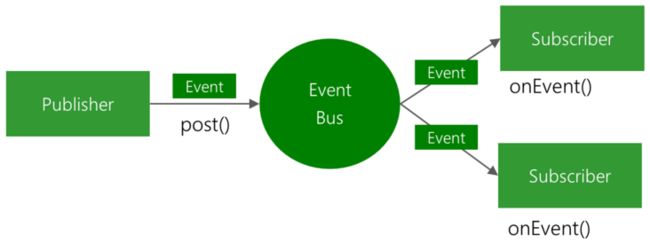EventBus 3.0源码分析
简介
EvenntBus 是一个开源库,它利用发布/订阅者者模式来对项目进行解耦。它可以利用很少的代码,来实现多组件间通信。android的组件间通信,我们不由得会想到handler消息机制和广播机制,通过它们也可以进行通信,但是使用它们进行通信,代码量多,组件间容易产生耦合引用。关于EventBus的工作模式,这里引用一张官方图帮助理解。
为什么会选择使用EventBus来做通信?
- 简化了组件间交流的方式
- 对事件通信双方进行解耦
- 可以灵活方便的指定工作线程,通过ThreadMode
- 速度快,性能好
- 库比较小,60k左右,对包大小无影响
- 使用这个库的app多,有权威性
- 功能多,使用方便
EventBus的使用也非常简单,三板斧。register,unregister, subscribe/post
三个重要的角色
1:Publisher 事件发布者
2:Subscriber 事件订阅者
3:Event 事件
Publisher post 事件后,Subscriber会自动收到事件(订阅方法会被主动调用,并将事件传递过来)。
使用
//倒入gradle 依赖
implementation 'org.greenrobot:eventbus:3.3.1'
1:定义事件类型
public static class MessageEvent { /* Additional fields if needed */ }2:在需要订阅事件的模块中注册EventBus,页面销毁时注意注销
@Override
protected void onStart() {
super.onStart();
EventBus.getDefault().register(this);
}
@Override
protected void onDestroy() {
super.onDestroy();
EventBus.getDefault().unregister(this);
}
3:注册需要接受的事件类型 //注意同一种事件类型不能重复注册。不然会崩溃,且订阅方法必须是public类型的。
@Subscribe(threadMode = ThreadMode.MAIN)
public void onMessageEvent(MessageEvent event) {
// Do something
}4.发送事件
EventBus.getDefault().post(new MessageEvent());
这是步骤3种的方法就会收到MessageEvent事件的回调源码分析
EventBus 主类中只有不到600行代码,非常精简。EventBus使用了对外提供了单例模型,内部构建使用了Build模式。
1 register
public void register(Object subscriber) {
if (AndroidDependenciesDetector.isAndroidSDKAvailable() && !AndroidDependenciesDetector.areAndroidComponentsAvailable()) {
// Crash if the user (developer) has not imported the Android compatibility library.
throw new RuntimeException("It looks like you are using EventBus on Android, " +
"make sure to add the \"eventbus\" Android library to your dependencies.");
}
//1从这里开始看,获取调用者的类对象。
Class subscriberClass = subscriber.getClass();
//2 找到订阅类中的订阅方法
List subscriberMethods = subscriberMethodFinder.findSubscriberMethods(subscriberClass);
//3遍历订阅方法,将订阅者和其中的订阅方法绑定。
synchronized (this) {
for (SubscriberMethod subscriberMethod : subscriberMethods) {
subscribe(subscriber, subscriberMethod);
}
}
} Step1
看下步骤2中的subscriberMethodFinder的findSubscriberMethods方法
List findSubscriberMethods(Class subscriberClass) {
//1首先从缓存map中拿到订阅类的订阅方法列表,使用了缓存提高性能,nice,不出所料METHOD_CACHE的类型是Map, List >
List subscriberMethods = METHOD_CACHE.get(subscriberClass);
//2 如果不为空,说明之前该类曾经注册过,该类的新对象不必重新做绑定了,因为此时的操作是类层面的
if (subscriberMethods != null) {
return subscriberMethods;
}
//如果subscriberMethods 为null,说明该类是第一次注册,需要将其中的接收方法保存起来,
//ignoreGeneratedIndex 默认为false
if (ignoreGeneratedIndex) {
subscriberMethods = findUsingReflection(subscriberClass);
} else {
subscriberMethods = findUsingInfo(subscriberClass);
}
//如果subscriberMethods为null,说明当前类对象没有生命订阅方法,抛出异常
if (subscriberMethods.isEmpty()) {
throw new EventBusException("Subscriber " + subscriberClass
+ " and its super classes have no public methods with the @Subscribe annotation");
} else {
//将当前注册类和其中的注册方法保存起来
METHOD_CACHE.put(subscriberClass, subscriberMethods);
return subscriberMethods;
}
} Step2
从步骤2中找出类的注册方法列表,然后遍历列表,调用下面的方法,将类对象和注册方法绑定。
private void subscribe(Object subscriber, SubscriberMethod subscriberMethod) {
//1 找到订阅方法的事件类型,即发送事件的MessageEvent.class
Class eventType = subscriberMethod.eventType;
//2 将订阅者类对象和订阅事件绑定成一个对象
Subscription newSubscription = new Subscription(subscriber, subscriberMethod);
//subscriptionsByEventType 这个集合肯定是用来放置同一事件类型的订阅集合的,因为一个事件可能会有多个订阅的。
CopyOnWriteArrayList subscriptions = subscriptionsByEventType.get(eventType);
if (subscriptions == null) {
subscriptions = new CopyOnWriteArrayList<>();
subscriptionsByEventType.put(eventType, subscriptions);
} else {
//如果一个订阅者多次订阅了一个事件(@Subscribe注解的方法的参数是同一类型),抛出异常
if (subscriptions.contains(newSubscription)) {
throw new EventBusException("Subscriber " + subscriber.getClass() + " already registered to event "
+ eventType);
}
}
//3 按照订阅方法中@Subscribe中的priority参数进行排序,默认为最低优先级0。subscriptions种的对象按优先级排序,收到事件后就会 按优先级进行回调
int size = subscriptions.size();
for (int i = 0; i <= size; i++) {
if (i == size || subscriberMethod.priority > subscriptions.get(i).subscriberMethod.priority) {
subscriptions.add(i, newSubscription);
break;
}
}
// typesBySubscriber类型Map>>,Key 为订阅者,value为订阅者中的订阅方法,用来记录每个订阅者内部都订阅了哪些事件类型
List> subscribedEvents = typesBySubscriber.get(subscriber);
if (subscribedEvents == null) {
subscribedEvents = new ArrayList<>();
typesBySubscriber.put(subscriber, subscribedEvents);
}
subscribedEvents.add(eventType);
//粘性事件相关
if (subscriberMethod.sticky) {
if (eventInheritance) {
// Existing sticky events of all subclasses of eventType have to be considered.
// Note: Iterating over all events may be inefficient with lots of sticky events,
// thus data structure should be changed to allow a more efficient lookup
// (e.g. an additional map storing sub classes of super classes: Class -> List).
Set, Object>> entries = stickyEvents.entrySet();
for (Map.Entry, Object> entry : entries) {
Class candidateEventType = entry.getKey();
if (eventType.isAssignableFrom(candidateEventType)) {
Object stickyEvent = entry.getValue();
checkPostStickyEventToSubscription(newSubscription, stickyEvent);
}
}
} else {
Object stickyEvent = stickyEvents.get(eventType);
checkPostStickyEventToSubscription(newSubscription, stickyEvent);
}
}
} 2 post
/** Posts the given event to the event bus. */
public void post(Object event) {
//1首先获取当前线程的工作状态
PostingThreadState postingState = currentPostingThreadState.get();
//2获取当前线程的任务队列
ListpostSingleEventForEventType
private boolean postSingleEventForEventType(Object event, PostingThreadState postingState, Class eventClass) {
CopyOnWriteArrayList subscriptions;
synchronized (this) {
//1获取该事件的所有订阅关系列表
subscriptions = subscriptionsByEventType.get(eventClass);
}
//2 遍历订阅关系列表,依次将事件发送到订阅者
if (subscriptions != null && !subscriptions.isEmpty()) {
for (Subscription subscription : subscriptions) {
postingState.event = event;
postingState.subscription = subscription;
boolean aborted;
try {
//将事件发送到订阅者
postToSubscription(subscription, event, postingState.isMainThread);
aborted = postingState.canceled;
} finally {
postingState.event = null;
postingState.subscription = null;
postingState.canceled = false;
}
if (aborted) {
break;
}
}
return true;
}
return false;
} postToSubscription
这里就比较关键了,最终到了事件分发的地方了。
private void postToSubscription(Subscription subscription, Object event, boolean isMainThread) {
//1 首先判断订阅关系中订阅方法的线程,就是声明线程时使用@Subcribe注解时传入的threadMode字段的值
switch (subscription.subscriberMethod.threadMode) {
case POSTING: //直接发送事件
invokeSubscriber(subscription, event);
break;
case MAIN: //在主线程相应事件
//事件发出线程是否是主线程
if (isMainThread) { 是,直接发送
invokeSubscriber(subscription, event);
} else {不是通过mainThreadPoster发送
mainThreadPoster.enqueue(subscription, event);
}
break;
case MAIN_ORDERED:
if (mainThreadPoster != null) {
mainThreadPoster.enqueue(subscription, event);
} else {
// temporary: technically not correct as poster not decoupled from subscriber
invokeSubscriber(subscription, event);
}
break;
case BACKGROUND: //在后台线程相应事件
//事件发出线程是否是主线程
if (isMainThread) {主线程发送事件,backgroundPoster转发
backgroundPoster.enqueue(subscription, event);
} else { 非主线程发送事件,直接发送
invokeSubscriber(subscription, event);
}
break;
case ASYNC: //异步线程相应事件
//通过asyncPoster发送事件
asyncPoster.enqueue(subscription, event);
break;
default:
throw new IllegalStateException("Unknown thread mode: " + subscription.subscriberMethod.threadMode);
}
}invokeSubscriber
void invokeSubscriber(Subscription subscription, Object event) {
try {
//非常暴力,直接通过回调调用订阅者中的订阅方法
subscription.subscriberMethod.method.invoke(subscription.subscriber, event);
} catch (InvocationTargetException e) {
handleSubscriberException(subscription, event, e.getCause());
} catch (IllegalAccessException e) {
throw new IllegalStateException("Unexpected exception", e);
}
}在postToSubscription中有三个重要的角色mainThreadPoster,backgroundPoster,asyncPoster
其中mainThreadPoster的类型是HandlerPoster。其实就是Handler。调用其enqueu()方法
而backgroundPoster和asyncPoster 本质都是Runnable
3 unregister
解绑方法就简单多了,重要的是就把register里提到的2个重要的几何中删除订阅者
/** Unregisters the given subscriber from all event classes. */
public synchronized void unregister(Object subscriber) {
//1 从typesBySubscriber找到订阅者所订阅的事件类型列表
List> subscribedTypes = typesBySubscriber.get(subscriber);
if (subscribedTypes != null) {
//2 遍历列表,依次解绑订阅者和事件类型。应该是从post分析里的订阅事件集合subscriptionsByEventType里移除对应事件类型的该订阅者
for (Class eventType : subscribedTypes) {
unsubscribeByEventType(subscriber, eventType);
}
//3移除订阅者
typesBySubscriber.remove(subscriber);
} else {
logger.log(Level.WARNING, "Subscriber to unregister was not registered before: " + subscriber.getClass());
}
}
/**
* 解绑订阅者和事件类型
* @param subscriber 订阅者
* @param eventType 订阅的事件类型
*/
private void unsubscribeByEventType(Object subscriber, Class eventType) {
//从subscriptionsByEventType里获取该订阅事件的订阅者集合。
List subscriptions = subscriptionsByEventType.get(eventType);
if (subscriptions != null) {
int size = subscriptions.size();
for (int i = 0; i < size; i++) {
//遍历集合,获取所有的订阅关系
Subscription subscription = subscriptions.get(i);
if (subscription.subscriber == subscriber) {
subscription.active = false;
subscriptions.remove(i);
//重要。不然会抛出ConcurrentModifyException
i--;
size--;
}
}
}
}
4 Subscribe注解
@Documented
@Retention(RetentionPolicy.RUNTIME)
@Target({ElementType.METHOD})
public @interface Subscribe {
ThreadMode threadMode() default ThreadMode.POSTING;
/**
* If true, delivers the most recent sticky event (posted with
* {@link EventBus#postSticky(Object)}) to this subscriber (if event available).
*/
boolean sticky() default false;
/** Subscriber priority to influence the order of event delivery.
* Within the same delivery thread ({@link ThreadMode}), higher priority subscribers will receive events before
* others with a lower priority. The default priority is 0. Note: the priority does *NOT* affect the order of
* delivery among subscribers with different {@link ThreadMode}s! */
int priority() default 0;
}5 ThreadMode
//定义事件回调方法工作线程的类
public enum ThreadMode {
/**
*直接在发送事件的线程里调用Subscriber,这个是默认的设置,事件交付开销最小,因为它避免了线程切换。因此它是那种很快完成的单任务 *默认的的线程工作模型。使用该模型的事件必须很快完成,因为当发布线程是主线程时,它可能阻塞主线程。
/
POSTING,
/**
* 在Android平台,订阅者将会在Android的主线程调用。如果发布线程时主线程,订阅方法将会被直接调用。进而阻赛发布线程,如果发布线 * 程不是主线程。事件将会排队等待分发。使用这种模式的订阅者必须快速完成任务,避免阻赛主线程。非Android平台和Posting一样
*/
MAIN,
/**
* 在Android平台,订阅者将会在Android的主线程调用。不同于MAIN,事件将会有序分发。确保了post调用时非阻赛的。
*/
MAIN_ORDERED,
/**
* 在Android平台,订阅者将会在后台线程被调用,如果发布线程不是主线程,订阅者将会被直接调用,如果发布线程时主线程,那么EventBus * 使用后台线程,进而有序分发所有事件,使用此模式的Subscribers应该快速完成任务以免阻赛后台线程。非Android平台,总是用后台线程 * 相应事件
*/
BACKGROUND,
/**
* 订阅者将会在单独的线程被调用,总是独立于发布线程和主线程。发布事件从不会等待使用这种模式的订阅方法。如果订阅方法执行耗时任务, * 则应该使用此模式。比如;网络访问。避免同时触发大量的长时间运行的异步订阅方法,从而限制并发的线程数量。EventBus 使用线程池来 * 高效的服用已完成异步订阅通知的线程
*/
ASYNC
}6 EventBus2.0和EventBus3.0的区别?
这是在面试过程中,面试官最常问的一个问题。
EventBus2.0和3.0最大的区别有两点:
1.EventBus2.0中我们在书写订阅方法时的名字必须是onEvent开头,然后通过命名不同来区别不同的线程模式。例如对应posting则命名为onEvent(),onEventMainThread()则对应main等。而3.0则可以用任何名字作为方法名称,只需要在方法名的前面用@Subscribe注解来进行注释,然后使用threadMode来设置在哪里线程中接收事件和处理事件
2.EventBus2.0使用的是反射的方式来查找所有的订阅方法,而3.0则是在编译时通过注解处理器的方式来查找所有的订阅方法。性能上来说,3.0比2.0要高的多。